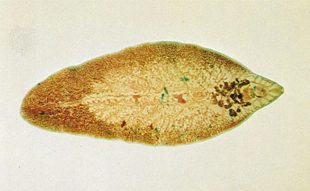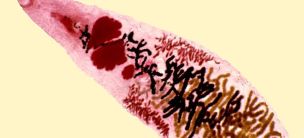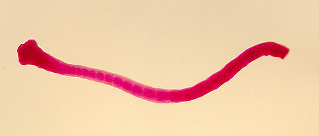Opisthorchiasis - a disease from the group of helminth infections that affect the liver and pancreas. There are about 21 million people infected with liver flukes. Giardiasis. A widespread protozoan disease, which can vary from subclinical to severe forms and is caused by the infection. Diseases worms, which is caused by the pork tapeworm. Disease from the group of helminth infections that affect the liver and pancreas.

ViDi parasites
Only persons with a medical background know all kinds of parasites in the human body. Most of them are not dangerous for health. Despite this, long-term course of certain diseases can cause serious complications.
Parasites on the body of adults and children
Not everyone knows what parasites are and where they live. From this disease affects persons of all ages. The human parasites include such organisms:
- fungi (yeast-like);
- helminths (nematodes, cestodes, trematodes);
- protozoa (single-celled);
- mites;
- lice;
- bed bugs;
- larvae of various insects.
All are distinguished by one feature: they lead a parasitic lifestyle, i.e. eat and grow at the expense of the person. Their life is different in duration. Some parasites can exist in people's body up to 20-30 years without causing a specific clinical picture. There is a classification of parasites, depending on their place of residence. The most commonly affected human skin. Such organisms are called parasites. These include bedbugs, lice, many fungi and mites. These creatures can live in the internal organs, lymphatic vessels and muscles. They are more dangerous because of the possibility of soft tissue damage.
Types of parasites depending on the localization

Some worms live in the liver. These include Fluke, Fasciola Hepatica, Echinococcus, ascarids, toxocariasis. There are visible worms that live in the lungs. This group includes Ascaris, Echinococcus, representatives of helminthiasis, agents paragonimoz. Some worms can reside in the bile ducts (cat Fluke, Fasciola Hepatica). Sometimes the process involves the soft touch. This is observed when infected with trichinosis. Rarely affects the kidneys and urinary tract. Parasites that live in those bodies are shistosoma. Often worms are found in blood and lymph vessels. Parasites affect mainly the skin. Possible involvement of mucous membranes. The most common diseases such as scabies, head, wardrobes and pubic lice, candidiasis. Lice feed on human blood, causing itching. They are found on the scalp, in the pubic region and on the inner layer of clothing that hugs the body.
As the parasites enter the human body?
You need to know not only information about those ViDi parasites occur in people, but how is the infection. Most people become infected quickly. It happens at home or during professional activities, when working on the land, after contact with Pets (cats, dogs, rodents). The development of intestinal parasites observed by ingestion of eggs or larvae of worms through the mouth. This occurs when consuming contaminated products, infected soft meat or fish, and also through dirty hands. People become infected mainly by the fecal-oral mechanism. Less common contact transmission, when the parasites penetrate the skin. It is possible for scabies, pediculosis, mycosis, the strongyloidiasis, and hookworm.
The parasites are transmitted from food (m meat, fish, vegetables, fruits, herbs, berries), raw water, dirty hands, the earth. There are helminths and protozoa that enter the human body through contact with contaminated feces pet dander. Some parasitic worms in the form of eggs and protozoa are transmitted via insects and ticks. Vectors can be mosquitoes, mosquitoes, flies. Isolated parasites that can be transmitted during sexual intercourse. This group includes Trichomonas, fungi, crabs. Of great importance are the creatures that go from one person to another directly through the skin and can live in a person for a long period of hours. So there is an infection - a disease caused by the dwarf tapeworm, which lives in the small intestine of man.

Representatives of a group of ectoparasites
It is necessary to know not only the visible dangerous creatures, but also those who are able to live on human skin. Very common such diseases as pediculosis. He is the head, wardrobes and pubic. Pathogen — louse. These parasites are striking integuments and their appendages (hair). Lice are often detected in childhood. Reasons — close contact with other children poor personal hygiene and crowding groups. Lice have the following distinctive features:
- there are ectoparasites (living on the surface of the human body);
- feed on blood;
- cause severe itching of the skin;
- size from 0.4 to 6 mm;
- live about a month;
- have a high fecundity;
- sensitive to high temperature;
- have piercing-sucking mouthparts.
During the examination the patients often found the eggs of lice (nits). They are tightly attached to the hair and are small. The symptoms of head lice often detected in children aged 15 to 24 years. Pubic lice are increasingly striking younger people. There are the following risk factors for infection with head lice:
- stay in kindergartens, boarding schools and orphanages;
- bad social conditions;
- the presence of the family of patients;
- work in kindergartens;
- wearing someone else's clothes;
- visit gromadskikh places (saunas, bath-houses, hairdressers);
- rare Laundry.

Often such parasites in the human body like scabies mites. They are easily transmitted from patient to the healthy by contact. The risk group includes persons with one bed and other personal care items. Scabies mites have chewing mouthparts. They live under the skin feeding on the epidermis. These parasites cause allergic reactions and rashes. Most often affects the skin of the abdomen, Breasts, thighs and between your toes. Creatures most active at night, so the symptoms (itching) is usually expressed in the evening and night.
Worms in the human intestine
Not everyone knows ViDi parasitic worms. They are divided into nematodes (round worms), cestodes (tapeworms) and trematodes (flukes). Many helminths live in the intestine of man. Bright representative of this group of endoparasites is Ascaris. These worms live in the small intestine. The larvae can get into other organs (liver, lungs). The incidence rate in the world up to 85 cases per 100 thousand persons. the Most sick small children. Parasites in the form of eggs enter the intestine by eating insufficiently washed products. Roundworms have the following features:
- have a long round body size up to 40 cm;
- treat geohelminths (partially develop in the environment);
- lay up to 240 thousand eggs per day.
A sick man along with the feces produces a large amount of eggs. They fall into the environment and for a while there ripen. The presence of this worm in the body can lead to inflammation of the intestinal mucosa to the development of obstruction. To the group of intestinal helminths login bot from group nematosis caused by worms of the genus pinworms. Pathogens are pinworms. These parasites live in the small and large intestine, often leading to dysbiosis, enteritis. Pinworms are small (1 cm) white worms. They have a pointed end with which they attach to the mucosa. These worms live up to 2 months. The risk group includes organized children who attend kindergartens and Junior schools. The infection is household or food way. Factors of transmission are the hands, toys, dishes, groceries, stationery. The parasites is the ability to crawl out to lay eggs. This happens mainly in the night time. The main symptoms of pinworms in the body is pain in the abdomen, irregular bowel movement and itching in the anus.

Protozoa-parasites of man
Only doctors know ViDi parasitic protozoa. A huge number of them. The most common single-celled:
- amoeba;
- balantidia;
- Trichomonas;
- Leishmania;
- Cryptosporidium;
- Giardia;
- malarial plasmodia;
- Toxoplasma;
- Trypanosoma.
Among the most common protozoosis giardiasis. This disease caused by unicellular microorganisms with a primary lesion of duodenum 12 and liver. The causative agent — Giardia. The human parasites of this type have the following characteristics:
- are unicellular mikroorganizmi;
- live in 2 forms (vegetative and spore);
- transmitted through food, water, dishes and household items;
- is transferred by insects;
- affect mainly children up to 10 years;
- value to 21 µm (vegetative forms);
- have flagella (vegetative forms);
- able to travel extensively.
These creatures are very persistent in the environment. Infection of humans is water, alimentary or contact-household ways. People infected with Giardia cysts. The peak incidence occurs in the spring and summer. Giardia is ubiquitous. The risk group includes children who attend organized groups. Most ill persons are not trained to forgive personal hygiene habits. Often during the examination of the patients revealed a micro-organism, like an amoeba. It is kind of simple. Creatures striking the gut and can contribute to the formation of abscesses in other organs (liver). These parasites are often detected in individuals who regularly miute hands. Amoeba live in the form of trophozoites and cysts. Latest stable in the environment. At risk for amebiasis include people with immunodeficiency and pregnant women. In addition to amoebas and Giardia in humans may be the Cryptosporidium. It is a microbe, a parasite in the intestines. Cryptosporidium cause diarrhea and other intestinal symptoms. Among the dangerous to humans parasites include malaria parasites. They are transferred by mosquitoes. Infection occurs through insect bites.

Clinical manifestations of parasites
Acquainted with the information about what parasites live in the intestines, you should know the basic symptoms of diseases caused by them. The presence in the body of pinworms is characterized by the irregularity on the type of diarrhea, flatulence, pain in lower abdomen, itching in the perianal region, irritability, rash, loss of appetite. Children with enterobiasis are often sick. Pinworms can cause the development of gastroduodenitis, enteritis and dysbiosis. If the body is roundworm, people are concerned about nausea, abdominal pain, anal itching, increased production of saliva, loss of appetite, weakness. Simple ascariasis can cause blockage of the intestine by adult parasites. In the phase of larval migration may cause rash and cough. Allergic reactions and indigestion are the main symptoms of intestinal helminths. Some worms are striking a soft touch. Outstanding representatives are Trichinella. They cause m Azov pain, allergic reactions, swelling. Such human parasites as flukes, affect the organs of the biliary system (liver, bladder and ducts).
This is manifested by nausea, vomiting, low grade fever, pain in the hypochondrium on the right. To creatures that dwells in the bladder and kidneys are shistosoma. They cause dysuria. In the urine of such patients may manifest the roof. Some human parasites are very dangerous and can not manifest itself. These include tapeworm. These tape worms can only parasitize on the body in the form of larvae. Man is a dead end for this helminth. Echinococcus, which lives in the liver or lungs, it forms bubbles (cysts). There may be several dozen. Lice cause itching of patients and can cause the development of eczema, pyoderma, and chronic dermatitis. On the skin the compound is a rash. The defeat of the human itch mite characterized by itching mainly in the evening and nighttime and a rash. In the presence in the body of malaria parasites observed you're shaking with fever, chills, dizziness, nausea, jaundice, increased liver and spleen.
The largest human parasites

Some parasites are microscopic, while others can reach a length of 20 m. the Largest of these are:a tapeworm (the causative agent of difillobotrioza), swine and bovine capni. These creatures have a narrow, flat body divided into many segments (proglottid). Pork tapeworm reaches 4 m in length. He has a head, a body and a suction Cup. Observed the hooks. Man acts as definitive host.
Sometimes in humans are parasites of the larvae of this helminth. The largest tapeworm is the beef tapeworm. Its body length is 20 m. This parasite causes a disease such as the beef tapeworm infection. Large individuals are able to intertwine, forming a tangle in the human intestine. This can cause problems with passing stool. Slightly smaller are the worms from the group of trematodes (a tapeworm). Infection it is possible by eating undercooked infected fish.
How to get rid of parasites? Man has no greater torment, than to wish to restore under the influence of dangerous creatures health, but not being able to do it. Self-therapy does not give good results. If there is even the slightest symptoms, you need to pay for medical care. Regardless of the type of parasites in humans, the doctor will accurately determine a diagnosis and find effective treatment.






































